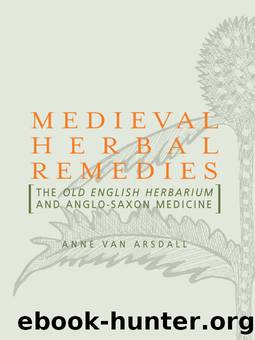Medieval Herbal Remedies by Van Arsdall Anne

Author:Van Arsdall, Anne
Language: eng
Format: epub
Publisher: Taylor & Francis (CAM)
Published: 2002-11-14T16:00:00+00:00
The Illustrations in the Cotton Old English Herbarium
Of all the manuscripts containing the Old English Herbarium, Cotton Vitellius C. iii is unique because of its illustrations. The subject of several specialized studies, the illustrations are of secondary interest here. Following the argument presented in chapter 3, from the standpoint of their use to the reader, the plant drawings should be considered aids to memory, schematics to assist someone who knew the plants fresh or dried. The three title pages of human figures at the beginning of the manuscript helped establish the authority of the work for the medieval reader as coming from ancient and accepted sources, but even without them, the Herbarium was so very well known, such illustrations were unnecessary. The authorities simply added to the value and usefulness of this codex. That all the illustrations can be linked to Continental sources bolsters the thesis advanced earlier that Anglo-Saxon medicine can be closely linked to a pan-European tradition.
The illustrations in the Cotton manuscript consist of: (1) three title pages on 11v, 19r, and 19v; (2) plant illustrations that are placed near the beginning of every entry in the body of the Herbarium and exist for every plant but the last one; (3) snakes, spiders, and scorpions appearing near the remedies in the Herbarium that would be made to cure the poison from their bite; and (4) animals that were used in preparing the remedies in the Medicina de Quadrupedibus, a work not covered here.
The three illuminated title pages have been the subject of considerable discussion, in fact more so than the numerous drawings of plants, animals, and snakes that accompany the remedy portion of the work. On 19r is a framed image with a large central figure holding plants in his hands, a centaur to his left, and a figure in classical robes to his right; below the frame are the names Escolapius, Plato, Centaurus. Above and below the human figures are animals and snakes. On 19v is the title of the workâHerbarium Apulei Platonici Quod Acceptit Ab Escolapio et Alchirone Centauro Magis<t>ro Achillisâencircled in a frame. Voigts, who has studied the illustrations in this manuscript extensively, interpreted these folios together as being author portraits, examples of a standard type of illustration present in herbals from classical times through the Middle Ages.
This author portrait is found between the table of contents and the first chapter of the herbal; it depicts the source of and the authority for the remedy book. Portrayed in this miniature are Aesculapius, Chiron, and, in the center, the putative author of the herbal, Apuleius Platonicus, often designated in herbals as Plato or Plato Apoliensis.7
Download
This site does not store any files on its server. We only index and link to content provided by other sites. Please contact the content providers to delete copyright contents if any and email us, we'll remove relevant links or contents immediately.
Inner Engineering: A Yogi's Guide to Joy by Sadhguru(6446)
The Power of Now: A Guide to Spiritual Enlightenment by Eckhart Tolle(5342)
Fear by Osho(4496)
Ikigai by Héctor García & Francesc Miralles(3900)
The Art of Happiness by The Dalai Lama(3850)
The Ultimate Bodybuilding Cookbook by Kendall Lou Schmidt(3710)
Yoga Therapy by Mark Stephens(3577)
The Little Book of Hygge by Meik Wiking(3449)
Why Buddhism is True by Robert Wright(3290)
The Healing Self by Deepak Chopra(3264)
Being Aware of Being Aware by Rupert Spira(3086)
The Hatha Yoga Pradipika (Translated) by Svatmarama(3078)
Shift into Freedom by Loch Kelly(3031)
Wild Words from Wild Women by Stephens Autumn(2939)
Work Clean by Dan Charnas(2897)
Happiness by Matthieu Ricard(2886)
More Language of Letting Go: 366 New Daily Meditations by Melody Beattie(2851)
Yoga Body & Mind Handbook by Jasmine Tarkeshi(2751)
Why I Am Not a Feminist by Jessa Crispin(2587)
